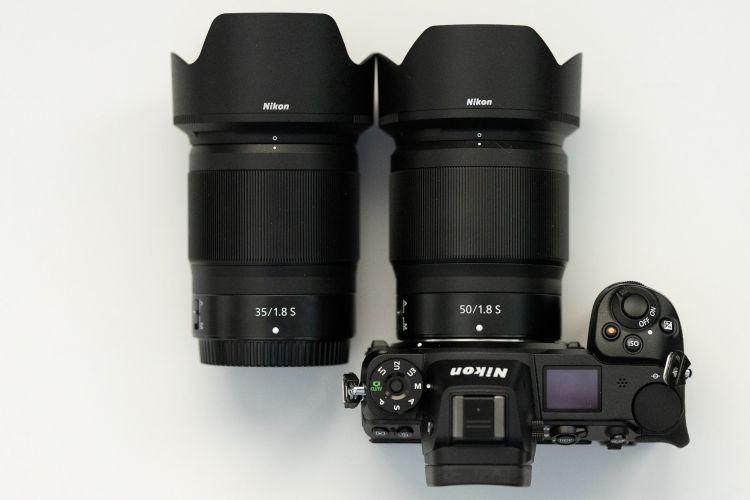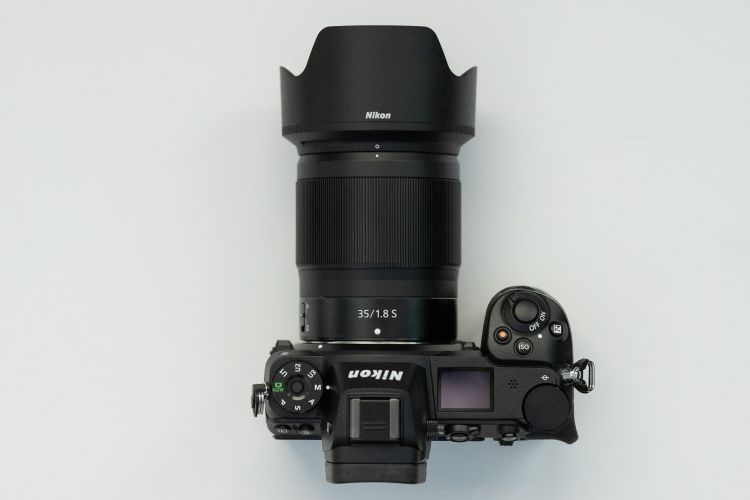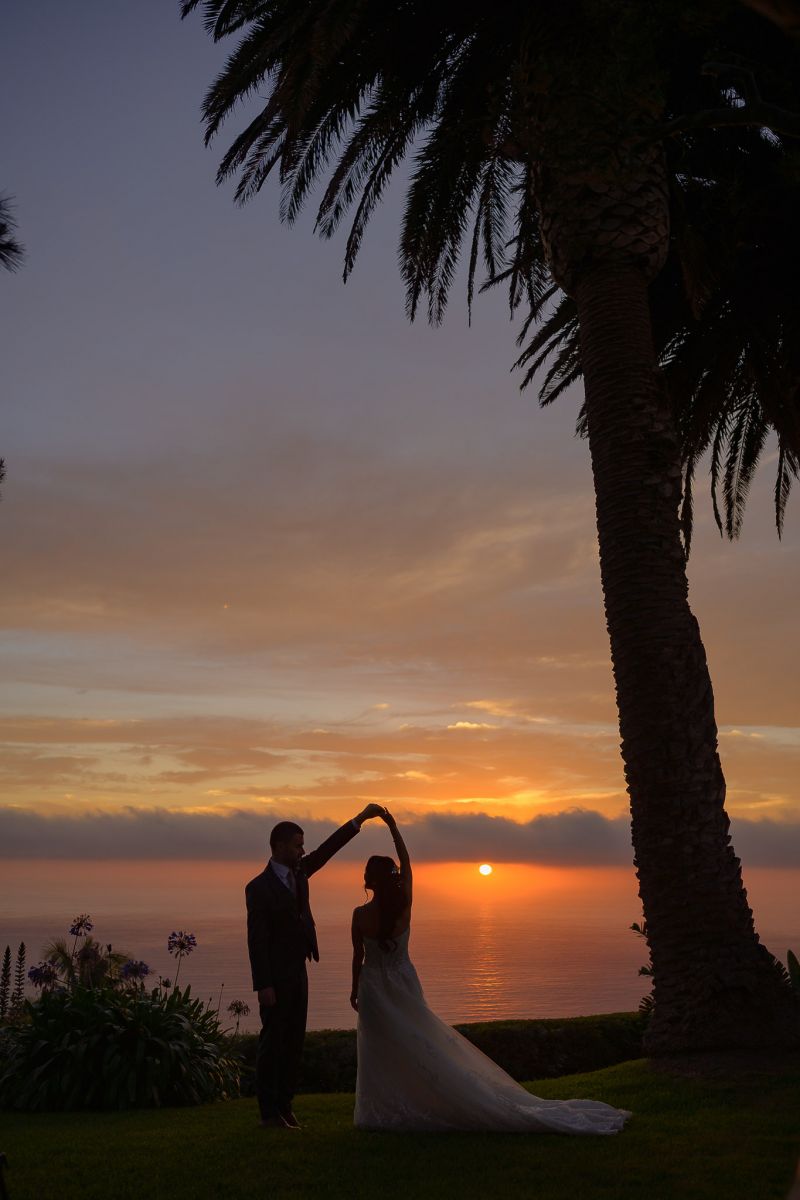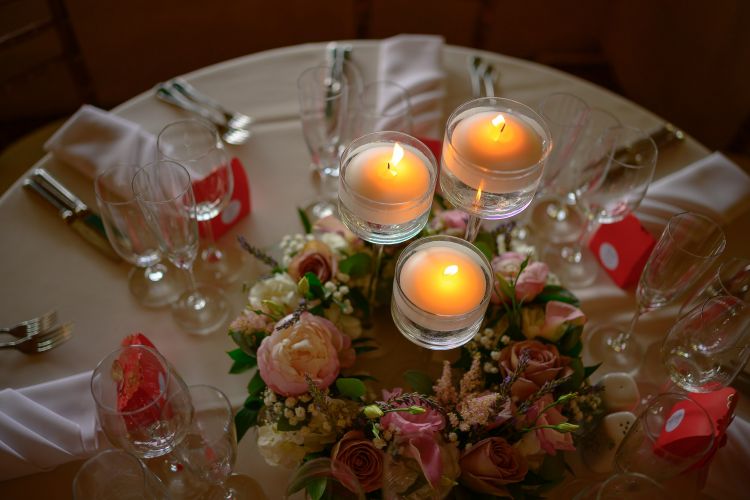
9.0 Score
It seems official: f/1.8 is the new f/1.4. At least, that is, for Nikon mirrorless shooters. Their trio of f/1.8 prime lenses for their 1-year-old Z-mount system are turning out to be above and beyond what you’re used to getting when you hear, “f/1.8”
Indeed, f/1.8 used to be the runt of the fast prime families, with f/1.4 and f/1.2 asserting their dominance as the professionals’ choice, the flagships of common focal lengths from 24mm to 85mm.
With their new, enormous mount, however, Nikon has a clear message for us: forget everything you thought you knew about f/1.8. This is an (almost) flagship quality lens, in a (sort of) competitively priced package.
We’ve been using the Nikkor Z 35mm f/1.8 S for a few months now, and have had opportunities to take it (mounted on a Nikon Z7) to every photography opportunity from weddings to DJ sets, travel landscape photography, and some casual street photography. Let’s see exactly how it performed!

Nikon Z 35mm f/1.8 S | Specifications
Price: $847 (Available at B&H, Adorama, & Amazon)
Aperture Range: f/1.8-16
Angle Of View: 63 degrees
Minimum Focus & Magnification: 9.84″ (25 cm), 0.19x
Autofocus: Silent Stepper Motor, no focus breathing
Optical Construction: 11 elements, 9 groups, 3 aspherical, 2 extra-low dispersion, Nano Crystal coatings, Super Integrated coatings
Mechanical Construction: Some plastic, some metal, fully weather-sealed
Filter Threads: 62mm
Dimensions: 2.87″ x 3.39″ (73×86mm)
Weight: 13.1 oz (370g)
Accessories: Caps, Hood, Pouch

Pros & Cons | Nikon Z 35mm f/1.8 S
We like to break down our reviews to the good and the bad because it’s a simple way to organize various aspects such as physical quality, image quality, and overall value.
In this case, we’re going to simplify things even more, and spoil it right away: It’s nearly 100% pros and zero cons, and the only nit-picks I can come up with are relatively obscure.
As you’ve already heard us raving when we reviewed the Nikon Z 50mm f/1.8 S, here’s the bottom line: The Nikon Z 35mm f/1.8 is a professional-grade lens. It’s better than any other f/1.8 prime we’ve ever tested in its range or nearby, and is indeed better in some ways than quite a few f/1.4 primes that cost twice as much, or more. It’s also on par with, or better than, any f/2.8 zoom that passes the focal length of 35mm.
In other words, if you’re a pro who likes sharp lenses that are built rock-solid, or if you’re just looking for the best “modest” medium-wide walk-around prime, the 35 Z/S is worth considering, even at its $850 price tag.

Build Quality & Handling
Again, just like the Nikon Z 50mm f/1.8 S which we already reviewed, the 35 Z/S is built really tough. It’s got enough metal parts and weather sealing gaskets to make it feel like a flagship lens, but it’s also got what feels like a little bit of that “high-grade plastic” that is still indestructible and helps make the lens even more lightweight.

Personally, I definitely prefer non-metal filter threads on my lenses, because I’ve found that metal can ding and mis-shape ever-so-slightly, causing filters to jam, while high-grade plastic seems impervious to all kinds of abuse.
Overall, the balance of the lens on a Z-mount body feels fantastic. At first glance the lens might look a bit larger than you’d expect for an f/1.8 prime, but keep in mind that this lens’ center of mass is much closer to the body, compared to any similar DSLR lens that would have to be mounted on the FTZ adapter. In short, it feels great to hand-hold.
If I had to nitpick, the only thing I can think of is that it’s actually really hard to tell the 35mm and 50mm Z/S’s apart; they look so identical that if you’re in a run-and-gun photography situation with both of them, you’ll need to double-check the number on the lens. Thankfully, it’s printed large! Some people put a “35” label on a piece of gaff tape for the front and rear caps, but I often shoot without any caps in my lens pouches, and I like to be able to throw any cap on any lens when I do need them.

Another complaint that I had with the 50mm Z/S is, if I had a choice, I’d prefer the focus rings on these lenses to be slightly smaller so that they’re easier to grip when mounting or unmounting from a camera. Also, maybe one of the focus rings on either the 35 or the 50 could have been a different length to help tell them apart.

If you ask me, these are pretty weak nitpicks, though! Speaking of silly things to complain about, Nikon managed to pick one of the most obscure filter thread sizes for both of these lenses, too: 62mm. From 52mm to 82mm, I have filters for literally every single thread size except 62mm. Oh well…
Image Quality
Now, let’s get to the good part. We don’t need to pixel-peep very much to discover just how incredibly sharp this lens is, though…
 Nikon Z 35mm f/1.8 S, Nikon Z7 | 1/200 sec, f/8, ISO 64
Nikon Z 35mm f/1.8 S, Nikon Z7 | 1/200 sec, f/8, ISO 64
 100% Crop, Extreme Corner, f/8, 45 megapixels (Nikon Z7)
100% Crop, Extreme Corner, f/8, 45 megapixels (Nikon Z7)
Incredible resolution + insane DR = a landscape photographer’s dream!
 Nikon Z 35mm f/1.8 S, Nikon Z7 | 1/640 sec, f/1.8, ISO 64
Nikon Z 35mm f/1.8 S, Nikon Z7 | 1/640 sec, f/1.8, ISO 64
Beautiful bokeh in a portable package makes a great travel & candid lens!
Sharpness
Here’s the quick-and-dirty verdict, if you’d like to skip the pixel-peeping sample crops below: This lens is quite sharp wide-open, and insanely sharp at f/2.8
 Center Crop, 100%, 45 megapixels
Center Crop, 100%, 45 megapixels
At f/1.8, there is a faint bit of low contrast and purple color fringing. However, to my surprise, stopping down doesn’t just gradually improve the results somewhere between f/2.8 or f/4. It (the slight haze) totally vanishes around f/2 or f/2.2.
That is rather unprecedented, considering that even many f/1.4 primes need to hit f/2 before they get truly sharp. On the Nikon 35 Z/S, f/2.8 is totally pin-sharp, and easily resolves 45 megapixels just as well as f/4 or f/5.6! Incredible.
OK, next let’s look at the extreme, extreme corners…
Fringing, Aberration, & Coma
 100% crop, extreme corner, 45 megapixels
100% crop, extreme corner, 45 megapixels
At f/1.8, in the extreme corners, we see the one weakness: it has enough coma/astigmatism that we definitely can’t pronounce this lens to be a new astro-landscape champion.
However, the immediate stop-down improvement coma is almost as good as in the dead-center: we see most of the coma/astigmatism go away between f/2.5 and f/2.8.
As a side note, and a Nikon lens roadmap prediction: we might expect Nikon to deliver even better performance from an f/1.4 Z/S 35mm lens that costs about twice as much, and/or an f/1.2 Z/S 35mm lens that costs about $2K or slightly more.
But for a “modest” f/1.8 Z-mount prime that costs $850, this is an impressive feat for extreme corner sharpness on a 45-megapixel sensor. (See below)

By the way, what if we go just a little bit in from those extreme, extreme corners? (The corners that you’ll probably be cropping away a lot of the time!) Let’s go to a spot that is still in the outer 10-15% of the image frame:


Here we see that the lens is indeed again “ridiculously sharp” (we only use the finest scientific terminology here at SLR Lounge!) by f/2.8, almost identical to the sharpness at f/5.6
Color & Contrast
 Nikon Z 35mm f/1.8 S, Nikon Z7 | 1/25 sec, (hand-held!) f/1.8, ISO 64
Nikon Z 35mm f/1.8 S, Nikon Z7 | 1/25 sec, (hand-held!) f/1.8, ISO 64
 Nikon Z 35mm f/1.8 S, Nikon Z7 | 1/1600 sec, f/1.8, ISO 64
Nikon Z 35mm f/1.8 S, Nikon Z7 | 1/1600 sec, f/1.8, ISO 64
 Nikon Z 35mm f/1.8 S, Nikon Z7 | 1/320 sec, f/2.8, ISO 64
Nikon Z 35mm f/1.8 S, Nikon Z7 | 1/320 sec, f/2.8, ISO 64
Beautiful colors and clear, crisp contrast seem to be par for the course on modern mirrorless lenses. For $850, you’re getting all the punchy tones and vibrant colors you could want.
Really, the bigger difference in colors and tones will arise when you get images into post-production, and compare the results achieved by someone who knows what they’re doing, and/o comparing different results from different raw conversion engines.
(All of the images in this review were processed using Adobe Lightroom, however, we are eager to get some Nikon Z-mount images processed in Capture One Pro 12 very soon!)
Bokeh & DOF
 Nikon Z 35mm f/1.8 S, Nikon Z7 | 1/2000 sec, f/1.8, ISO 100
Nikon Z 35mm f/1.8 S, Nikon Z7 | 1/2000 sec, f/1.8, ISO 100
One reason why many serious photographers don’t count f/1.8 as being a “serious” aperture is that, obviously, f/1.4 offers shallower depth.
However, in my ~15 years as a wedding & portrait photographer, I’ve learned one thing: DOF and bokeh are not the same thing. Sure, you can have slightly less DOF at f/1.4, but the characteristics of the bokeh could still be un-flattering, or “busy” as it’s called.
Alternately, you can have gorgeous, buttery bokeh at any aperture, including f/1.8. Of course having gorgeous, buttery bokeh AND f/1.4 or f/1.2 at your disposal would be the holy grail, but for that, you usually need to go with something truly exotic, which translate to expensive and heavy, such as the Canon RF 50mm f/1.2…
Simply put, though, for an f/1.8 prime, or even for an f/1.4 prime, this is beautiful bokeh…
 Nikon Z 35mm f/1.8 S, Nikon Z7 | 1/1000 sec, f/1.8, ISO 100
Nikon Z 35mm f/1.8 S, Nikon Z7 | 1/1000 sec, f/1.8, ISO 100
 Nikon Z 35mm f/1.8 S, Nikon Z7 | 1/1600 sec, f/1.8, ISO 64
Nikon Z 35mm f/1.8 S, Nikon Z7 | 1/1600 sec, f/1.8, ISO 64
 Nikon Z 35mm f/1.8 S, Nikon Z7 | 1/100 sec, f/1.8, ISO 200
Nikon Z 35mm f/1.8 S, Nikon Z7 | 1/100 sec, f/1.8, ISO 200
 Nikon Z 35mm f/1.8 S, Nikon Z7 | 1/1000 sec, f/1.8, ISO 64
Nikon Z 35mm f/1.8 S, Nikon Z7 | 1/1000 sec, f/1.8, ISO 64
So, having said that, I’m personally less attentive of the exact aperture, and more interested in how the bokeh of a lens actually looks.
Verdict on bokeh: the Nikon Z 35mm f/1.8 S is a winner. Background blur is just gorgeous, and the overall DOF at f/1.8 is more than enough to create that beautiful shallow look that adds emphasis to a subject in a candid or active situation.
Vignetting, Distortion, Flare, & Sunstars
 Nikon Z 35mm f/1.8 S, Nikon Z7 | 1/10 sec, (hand-held!) f/11, ISO 64
Nikon Z 35mm f/1.8 S, Nikon Z7 | 1/10 sec, (hand-held!) f/11, ISO 64
Sunstars are gorgeous at some apertures, and f/11 is my usual favorite, however, due to the rounded nature of the blades, the pin-point sharp character of the sunstar points can change depending on the aperture you’re using and the size of the light source. Try hitting f/11 for the best sunstars, (yes, better than f/14-16!) and try making the light source as pin-point as possible.
 Nikon Z 35mm f/1.8 S, Nikon Z7 | 1/80 sec, f/2, ISO 1600
Nikon Z 35mm f/1.8 S, Nikon Z7 | 1/80 sec, f/2, ISO 1600
Flare is well-controlled, and again if you manage your light sources, you might have zero flare “dots”!
Vignetting is present at f/1.8, as with any fast lens wide-open, however, it’s very minor and natural looking. Regarding vignetting, however, we have a conundrum: all of the latest mirrorless lenses have a built-in correction profile, but on some prime lenses we’re noticing that it’s still not fully corrected when shot wide-open, so we’re doing additional testing to learn just how built-in lens corrections work. Stay tuned for an extensive report on mirrorless lens profile corrections!
Nikon Z 35mm f/1.8 S Versus The Competition

First and foremost, there’s no native Z-mount competition for this lens, unless you count the fact that Nikon has two 24-70mm zooms now that of course pass 35mm, even though they do it at f/2.8 and f/4.
The next-closest thing will be your existing Nikon F-mount DSLR lenses, on the Nikon FTZ adapter. Your older AF-D lenses won’t autofocus at all, so you can only choose from the AFS-G (SWM autofocus) primes, the Nikon 35mm f/1.4 G and 35mm f/1.8 G.
The previous Nikkor 35mm f/1.8 G prime is decent, and relatively affordable at just $476 whenever Nikon’s instant savings ($50) is available. However, it’s not nearly as close to flawless as this new Z-mount prime. If you’re shooting casually on a 24-megapixel Z6 and just want a basic medium-wide prime, $850 might be a bit much, indeed. However if you’re shooting important images on a 45-megapixel Z7, then you’ll find that the Z 35 1.8 S not only “destroys” the older Nikon f/1.8, but actually beats the AFS-G 35mm f/1.4 in most respects, and that’s a lens that costs about twice as much! ($1547 or $1697, depending on that $150 instant savings)
Last but not least, there are some Nikon F-mount primes from third parties that you might consider using on the FTZ adapter, too. Tamron and Sigma have some awesome options at 35mm, including the venerable Sigma 35mm f/1.4 Art (which is $899, but often on sale for $699!) …and the impressive new Tamron SP 35mm f/1.4, which is also “just” $899.
Both of those f/1.4 primes, especially the newest Tamron, are truly stellar lenses, with the image quality (and heft) of a flagship optic. The only caveat I can think of is that you never know what compatibility or reliability issues you might run into with Nikon autofocus technology. (At present, both of these lenses should function normally on the FTZ adapter.)
All in all, having a native lens that doesn’t require an adapter is a beautiful thing; the convenience-VS-frustration factor cannot be expressed adequately in written form. Having said that, if you’re either using the FTZ adapter exclusively or only using it for just one lens, it’s not a deal-breaker.
Nikon Z 35mm f/1.8 S | More Sample Images
 Nikon Z 35mm f/1.8 S, Nikon Z7 | 1/125 sec, f/1.8, ISO 64
Nikon Z 35mm f/1.8 S, Nikon Z7 | 1/125 sec, f/1.8, ISO 64
 Nikon Z 35mm f/1.8 S, Nikon Z7 | 1/100 sec, f/1.8, ISO 100
Nikon Z 35mm f/1.8 S, Nikon Z7 | 1/100 sec, f/1.8, ISO 100
 Nikon Z 35mm f/1.8 S, Nikon Z7 | 1/80 sec, hand-held, f/1.8, ISO 3200
Nikon Z 35mm f/1.8 S, Nikon Z7 | 1/80 sec, hand-held, f/1.8, ISO 3200
 100% crop, f/1.8, 45-megapixels, fine-radius sharpening applied
100% crop, f/1.8, 45-megapixels, fine-radius sharpening applied
Nikon Z 35mm f/1.8 S | Final Verdict
The engineers outdid themselves on this one. It’s not perfect, but it’s still perfect for most photographers from serious hobbyists to working professionals. Portraits, weddings, travel, landscapes, …almost any type of photographer will find a good 35mm prime to be very useful. Personally, I’m a huge fan of 35mm instead of 50mm, for many types of photography.
To be honest, as not just a landscape and portrait photographer but also as a serious nightscape and timelapse photographer, …I’m waiting to see how the imminent Nikon Z 24mm f/1.8 S and Nikon Z 20mm f/1.8 S perform, because that’s usually a preferable focal range for astro-landscape work.
All in all, though, for $850 you won’t be disappointed. Forget everything you thought you knew about f/1.8 lenses, and give this impressive optic a try!
Check Pricing & Availability Of The Nikon Z 35mm f/1.8 S
B&H ($847) | Adorama | Amazon
Matthew Saville
Follow his wilderness nightscape adventures on Instagram: instagram.com/astrolandscapes




Get Connected!